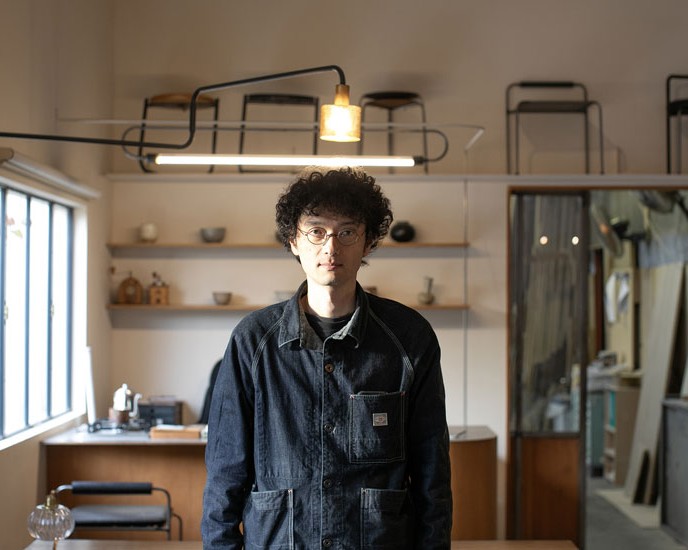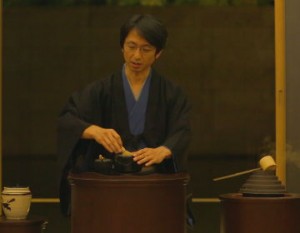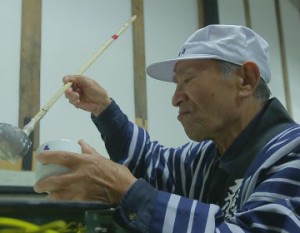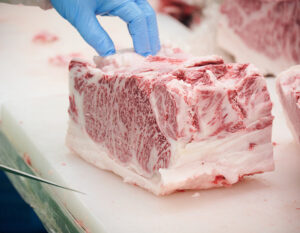Takashi Kita of “KITAWORKS” originates from a welding shop started by his father. The furniture he creates by combining iron, stainless steel, copper, brass, and other metals with wood, “minimalism is at the foundation of my work, and this is reflected in my work,” he says. How did he come up with the designs and delicate processing techniques that attract numerous space designers?
Attention-grabbing products

KITAWORKS designs and manufactures store fixtures, residential furniture, and interior furnishings, such as chairs with seats and backs formed from a single perforated stainless steel plate, tables with wood tops on extremely thin steel frames, and cabinets with brass frames, that are not only designed but also crafted down to the smallest detail. The furniture is designed and manufactured by “KITAWORKS”, and is crafted to the highest level of detail. These include the directly managed “ARTS & SCIENCE” store in Kyoto, for which Sonia Park serves as creative director; “LOG,” a hotel, café, bar, dining room, and store based on the concept of “living like you live,” and “VERVE” at Yebisu Garden Place in Tokyo. VERVE COFFEE ROASTERS” at Yebisu Garden Place in Tokyo, etc., and is also collaborating with the interior design company AXCIS on lighting fixtures and other products.
Originally an ironworks founded by his father

Tsuyama City, where KITAWORKS is located, is the third largest city in Okayama, located in northeastern Okayama Prefecture. The area has long been a transportation hub, and since the construction of Tsuyama Castle in the Warring States Period (1467-1568), it has served as the center of the surrounding area, and the atmosphere of a castle town remains strong today.
The origin of KITAWORKS is an ironworks founded by Takashi Kita’s father in 1978. When he was 30 years old, he decided to teach himself woodworking in order to build furniture and fittings for his new home. After making several pieces by combining frames made at an ironworks and wood, he was asked to make them by friends who had seen them. At a time when the number of orders for machinery and equipment was decreasing, he decided to take on this project in earnest, hoping that it would become his business.
Finding a balance between functionality and appearance

When the company switched from manufacturing machinery and equipment to furniture and interior design, the key point was to reconcile the functionality and appearance of the product. For example, a chair to be delivered to a factory must be sturdy and free from defects. However, chairs used in daily life should be functional and stylish at the same time. The search for such a compromise was the beginning of the “KITAWORKS” style.
Minimalism at the core

When Mr. KITA thinks about designing new furniture, he often starts with the form. The “KITAWORKS” style appears in the way the strength of the structure that realizes the form is maintained. Take the example of a cabinet with a glass panel inlaid in an iron frame, for example, a “support” is made in the thin frame to fit the glass. A groove is made in the steel, and the four sides of the glass are wrapped in a rubber band to hold it in place. However, Mr. Kida easily overcame this difficulty and hid the fixing rubber so that it could not be seen from the outside to make the overall appearance more neat and tidy. This is achieved by digging a deeper groove and deeply fitting the glass.
This process, he says, is “like eliminating unnecessary lines and thickness. When he first started making the cabinet, his glass supplier gave him advice on how far he could go with the processing, and he was able to achieve this detailing. I want to make the form I have in mind a reality. So I make it once, and if something is missing, I correct it and reinforce it. Finding little decorations and beautiful angles for lines is part of the process. “I have an intuitive feeling that if I push the envelope, it will become minimalist,” he says. Minimalism is at the root of who I am, and I think it is reflected in what I make,” he says.
What we can do in this factory is originality.

KITAWORKS” was launched in 2009 and gained recognition through its participation in the ‘Field of Crafts Kurashiki’ event held every May in Kurashiki City, Okayama Prefecture, where craftspeople from all over Japan gather. We get a lot of specific orders like, “Can you make something like this? Once an order was placed, the person introduced the product to his/her acquaintances, and the word of mouth spread, and orders began coming in from Hiroshima and Tokyo.
Currently, iron is the most commonly used material, and stainless steel, aluminum, brass, and other materials are often combined with oak. His furniture is also characterized by its painted iron finish, and is used in the bar at LOG in Onomichi City, which was created by Studio Mumbai, an internationally acclaimed exemplar of “slow design,” a concept that emphasizes the importance of taking the time and effort to produce good products in small quantities as opposed to mass production. The table was the first to be coated with lacquer. The tabletop is made of wood and the legs are made of iron, but when the lacquer is applied over the entire surface, the original materials and differences become indistinguishable, giving the table an unidentified, austere flavor in a space created from an apartment in the early 1960s.
As I began to make furniture, I began to look at furniture and architecture from around the world, and I actually used furniture that is considered a masterpiece, such as Hans Wegner’s Y chair in Denmark. The number of vintage furniture I liked also increased. Even so, the source of his designs is still within himself, as he continues to create things that he thinks are interesting. I live in the northern part of Okayama Prefecture near the mountains, and I think that if you look into the nature that I feel there, it becomes minimalist, and I think that is reflected in the furniture as well. What we can do at this factory is limited. But I think that is what makes it unique,” he says.
The production of the “LOG” table has spread the name “KITAWORKS” around the world. The company receives orders not only from Japan but also from overseas, and currently the ratio of orders to production is half and half. The company’s strength lies in the fact that ideas that come to mind can be immediately tried and tested at the factory. Sometimes they playfully create lighting fixtures, candle holders, toilet paper holders, and other items, seeking a balance between functionality, decoration, and a sense of object.
KITAWORKS’ craftsmanship is centered on minimalism, and its focus on form, “making things that look cool,” coexists with the pursuit of functionality that stems from its roots in its father’s ironworks. KITAWORKS has established a one-of-a-kind style through a process that fosters a sensitivity to combining materials by taking advantage of their characteristics and a processing technique that calculates even the smallest shades of detail.











